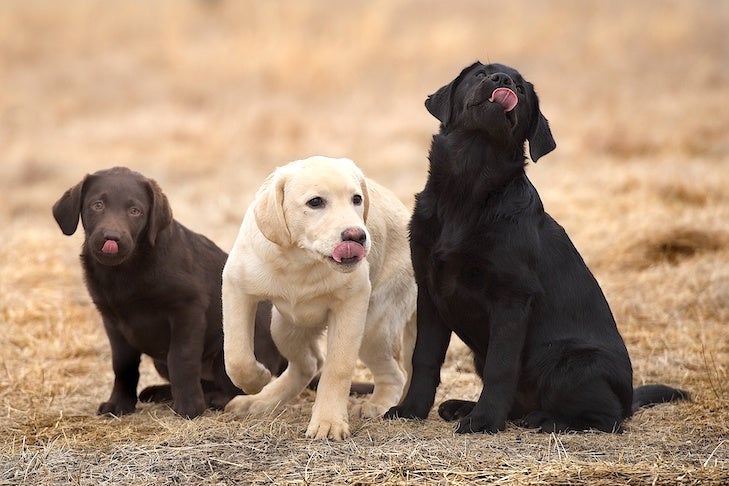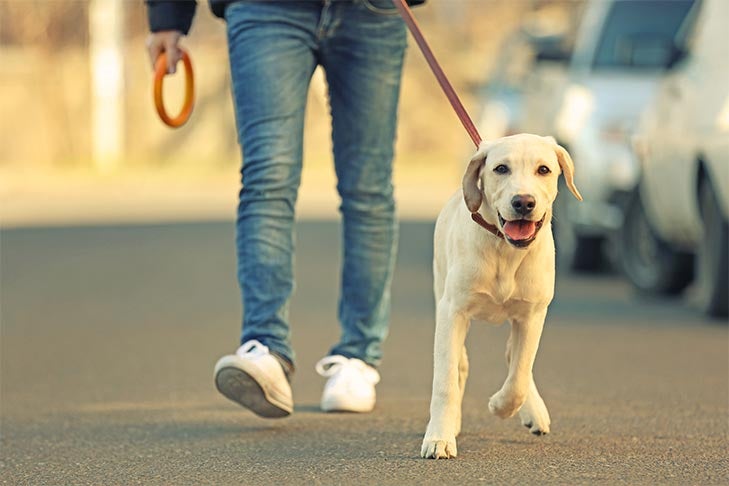
AKC is a participant in affiliate advertising programs designed to provide a means for sites to earn advertising fees by advertising and linking to akc.org. If you purchase a product through this article, we may receive a portion of the sale.
Friendly, active, and outgoing, Labrador Retrievers regularly rank among the most popular dog breeds. There’s a lot to love, and for first-time Lab owners, there’s a lot to get to know — especially over the course of the initial months of your puppy’s first year of life.
So what are the key milestones and firsts to prepare for as you welcome your Labrador Retriever puppy into your home? We talked to Cathy Straub Benedict of Cabin Labradors and Betty Barkley of Breton Gate Labrador Retrievers, both of whom have been breeders for more than 35 years.
Key Milestones: 8 Weeks
At eight weeks, it’s safe for Lab puppies to leave their mothers and litters and become a member of your family. When welcoming a Labrador Retriever into your pack, be prepared for these first key milestones, starting right when your new puppy enters your home.
1. Puppy Proofing
Similar to how we baby-proof our homes in anticipation of the arrival of a new baby, Lab families should plan on puppy-proofing your home, before your new dog joins the family.

“Chewing is a constant concern for the first year,” says Barkley. That’s why she recommends stocking up on chew toys as a healthy alternative to other household items your puppy may decide to teethe on instead. She recommends putting items you don’t want your dogs to chew away and out of sight.
“It’s also important to learn about foods and plants that are poisonous to Labs,” she added. “Some house plants need to be moved from the area where the puppy goes.”
2. Socialization
“Socialization is number one,” says Straub Benedict. “Labradors are people dogs. If you don’t want to spend a lot of time with your dog, get a cat.” Barkley says that new Labs should be carefully introduced to other dogs in the house, if applicable. (See our guide: How to introduce puppies into homes with senior dogs.)
Her advice? Make sure the older dog knows they’re the top dog. “Feed them first, then the puppy, ideally in a crate,” she explains. “Supervise the two to be sure they are not too wild and that the older one is being kind to the puppy.”
3. Grooming
Barkley and Straub Benedict both recommend getting into good grooming habits right from the start.
Lab puppies’ nails should be kept short (see our guide to trimming your dog’s nails safely). Barkley adds that this is a good time to clean your dog’s teeth and check and clean your dog’s ears. She recommends making this combo of nail trimming, ear cleaning, and teeth brushing a weekly routine.
In terms of baths, Labs are easy to groom. You should only need to bathe your Lab puppy about once a month, she adds.

4. House Training and Light Activities
It will take some effort to help your Lab become house-trained. The good news is that Retrievers make for great students. “Labs love to please and are quick learners,” says Barkley. “They can start learning basic obedience and parlor tricks as soon as they are in their new homes.”
For potty training your puppy, she recommends taking puppies outside first thing once they wake up and then again every half hour, using treats as a reward to keep them motivated. At this point, strenuous activities — such as jogging or more advanced obedience training —should be avoided, explain both breeders.
“I like to let a puppy be a puppy for the first six months, then we start basic training,” says Straub Benedict.
But now is a good time to introduce fun games like fetch for playtime and short walks on a leash. “Dog walks are fun for puppies, but they can tire quickly and might stop where you are, hoping for a ride home,” explains Barkley.
She recommends about five minutes of activity per month of age and discourages taking puppies to dog parks at this stage.
Key Milestone: 3–6 Months
These early months will be filled with plenty of learning and development.
5. Learning to Swim
Straub Benedict teaches her Labs to swim starting at about three months. “They do have to be taught to swim, so they can’t just be thrown in a pool with no way shown to them to get out safely,” she explains.
6. Taking the Stairs
While your dog may be gracefully walking around inside and outside your home, Barkley doesn’t recommend having your puppy using the stairs until about four months and up.
7. Obedience Training Classes
Starting at around four months — after your pet gets the first round of puppy vaccines —you can advance beyond the basic training you’ve already begun. For your puppy’s safety, Barkley recommends making sure any puppy obedience school or program you select requires all enrolled dogs to have their shots, too.
“A puppy class can be valuable to socializing and learning good manners,” she says. “I suggest visiting a class before to see how it is organized and safe.”
8. Teething
Expect your Lab’s puppy teeth to become loose and fall out around four to five months. “Checking the mouth during this time can detect a problem if a baby tooth is not being pushed out correctly by the adult teeth,” says Barkley.
“Rarely, a baby tooth might need to be pulled. I have wiggled a few free too.”
9. Longer Leash Walks
Until six months, leash walks should be short — at this time they can become gradually longer, but running or jogging should still be avoided.

Key Milestone: 7+ Months
This may be when your dog begins to mature sexually.
10. Sexual Maturity
There’s no set age at which Labrador Retrievers first reach sexual maturity. Barkley says this milestone may happen as early as seven months or take until a dog is nearly two years old, at 22 months. Before this stage, you should have discussed your spaying or neutering options with your breeder and vet.
“New studies encourage large dogs not to be spayed until their growth plates close,” she explains, adding that hormones play a major role in skeletal development. “This might not happen until 18 months or older.”
Diapers are one option for owners to use during this time.
Key Milestone: 12 Months
Congratulations, it’s your puppy’s first birthday!
11. Food Transition
At this time, you can plan to transition your pet from puppy to adult dog food, following the feeding guidelines offered on the label.
12. Jogging
Now your Lab is finally at a stage where it’s safe to go jogging with your dog. Enjoy!

